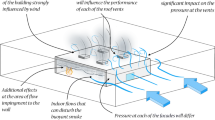Abstract
The rate of spread of a wildfire increases markedly when a wind springs up. Why and how this happens is still not completely understood. However, by using a judicious mixture of laboratory experiments, field experiments, sensitivity analyses of existing wildfire spread models and physical reasoning it is possible to identify some features that have not been adequately considered in the past. In particular: (i) the energetics of wind-blown wildfires indicate that a fire-wind may not exist and that the wind may blow through the fire line. ii) The rate of spread of the fire-front depends on the atmospheric stability such that the fire-front speeds are 50% or more faster during winds in the 2 to 6 m/s range under unstable conditions, iii) The wind speed acting on the flame provides an upper limit to the flame propagation speed. Existing attempts to constrain the propagation rate of fire-spread models at high wind speeds appear incorrect and, iv) wind fluctuations interacting with the standing fuel generate sweeps of downward air which carry the flame into the fuel bed and directly preheat the fuel.
Similar content being viewed by others
References
Albini, F. A.: 1982, ‘Response of Free-Burning Fires to Nonsteady Wind’, Combust. Sci. Tech. 29, 225–241.
Albini, F. A. and Baughman, R. A.: 1979, ‘Estimating Windspeed for Predicting Wildland Fire Behavior’, Research Paper INT-221, USDA Forest Service, Ogden, Utah.
Alexander, M. E.: 1982, ‘Calculating and Interpreting Forest Fire Intensities’, Can. J. Bot. 60, 349–357.
Anderson, H. E.: 1969, ‘Heat Transfer and Fire Spread’, Report INT-69, USDA Forest Service, Ogden, Utah.
Beer, T.: 1983, Environmental Oceanography, Pergamon Press, Oxford.
Beer, T.: 1990, Applied Environmetrics Meteorological Tables, Applied Environmetrics, Balwyn.
Byram, G. M.: 1959, ‘Combustion of Forest Fuels’, in K. P. Davis (Ed.), Forest Fire Control and Use, McGraw-Hill, New York.
Carslaw, H. S. and Jaeger, H. W.: 1959 Conduction of Heat in Solids, 2nd edn., Clarendon Press, Oxford.
Chandler, C., Cheney, P., Thomas, P., Trabaud, L. and Williams, D.: 1983, Fire in Forestry, Volume 1, John Wiley & Sons, New York.
Cheney, N. P.: 1981, ‘Fire Behaviour’, in A. M. Gill, R. H. Groves, and I. R. Noble (eds.), Fire and the Australian Biota, Australian Academy of Science, Canberra. pp 151–175.
De Mestre, N. J., Catchpole, E. A., Anderson, D. H. and Rothermel, R. C.: 1989, ‘Uniform Propagation of a Planar Fire Front without Wind’, Combust. Sci. Tech. 65, 231–244.
Durre, A. M.: 1989, ‘Mid-flame Wind Speed and the Rothermel Rate-of-Spread’, in Proc. 8th Biennial Conf. Simulation Soc. Aust., Canberra.
Durre, A. M. and Beer, T.: 1989, ‘Wind Information Prediction Study: Annaburroo Meteorological Data Analysis’, Technical Paper 17, Division of Atmospheric Research, CSIRO, Australia.
Eckert, E. R. G. and Drake, R. M., Jr.: 1959, Heat and Mass Transfer, McGraw-Hill, New York.
Finnigan, J. J. and Raupach, M. R.: 1987, ‘Transfer Processes in Plant Canopies in Relation to Stomatal Characteristics’;. In: E. Zeiger, G. D. Farquhar, and I. R. Cowan (eds.), Stomatal Function, Stanford University Press, Stanford, CA, pp. 385–429.
Garratt, J. R.: 1978, ‘Flux Profile Relations above Tall Vegetation’, Q. J. Roy. Meteorol. Soc. 104, 199–211.
Garratt, J. R.: 1980, ‘Surface Influence upon Vertical Profiles in the Atmospheric Near-Surface Layer’, Q. J. Roy. Meteorol. Soc. 106, 803–819.
Grishin, A. M., Gruzin, A. D. and Gruzina, E. E.: 1984, ‘Aerodynamics and Heat Exchange between the Front of a Forest Fire and the Surface Layer of the Atmosphere’, J. Applied Mech. & Tech Phys. 25, 889–894.
International Critical Tables, 1929: Volume 5, p. 167, McGraw-Hill, New York.
McArthur, A. G.: 1968, ‘The Tasmanian Bushfires of 7th February 1967, and Associated Fire Behaviour Characteristics’, in Conf. Papers, 2nd Aust. Natl. Conf. on Fire, Sydney, pp. 25–48.
McGuire, J. H.: 1953, ‘Heat Transfer by Radiation’, Fire Research Special Report No. 2, H.M.S.O., London.
Nelson, R. M.: 1986, ‘Measurement of Headfire Intensity in Litter Fuels’, in A. L. Koonce, (ed.), Prescribed Burning in the Midwest, University of Wisconsin, Stevens Point.
Nelson, R. M. and Adkins, C. M.: 1986, ‘Flame Characteristics of Wind-Driven Surface Fires’, Can. J. For. Res. 16, 1293–1300.
Pearman, G. I., Weaver, H. L. and Tanner, C. B.: 1972, ‘Boundary Layer Heat Transfer Coefficients under Field Conditions’, Agric. Meteorol. 10, 83–92.
Raupach, M. R.: 1990, ‘Similarity Analysis of the Interaction of Bushfire Plumes with Ambient Winds’, Math. & Comput. Modelling (in press).
Raupach, M. R., Finnigan, J. J. and Brunet, Y.: 1989, Coherent Eddies in Vegetation Canopies, Proc. Fourth Australasian Conf. Heat Mass Transfer, Christchurch, New Zealand, pp. 75–90.
Rothermel, R. C.: 1972, ‘A Mathematical Model for Predicting Fire Spread in Wildland Fuels’, Research paper INT-115, USDA Forest Service, Ogden Utah.
Skaar, C.: 1972, Water in Wood, Syracuse University Press, Syracuse, p. 140.
Sneeuwjagt, R. J. and Frandsen, W. H.: 1977, ‘Behaviour of Experimental Grass Fires vs. Predictions based on Rothermel's Fire Model’, Can J. For. Res. 7, 357–367.
Smith, R. K., Morton, B. R. and Leslie, L. M.: 1975, ‘The Role of Dynamic Pressure in Generating Fire Wind’, J. Fluid Mech. 68, 1–19.
Thomas, P. H.: 1971, ‘Rates of Spread of Some Wind-Driven Fires’, Forestry, 44, 155–175.
Turner, J. S.: 1973, Buoyancy Effects in Fluids, University Press, Cambridge.
Yih, C. S.: 1977, ‘Fluid Mechanics — A Concise Introduction to the Theory’, Corrected edition, West River Press, Michigan.
Author information
Authors and Affiliations
Rights and permissions
About this article
Cite this article
Beer, T. The interaction of wind and fire. Boundary-Layer Meteorol 54, 287–308 (1991). https://doi.org/10.1007/BF00183958
Accepted:
Issue Date:
DOI: https://doi.org/10.1007/BF00183958




